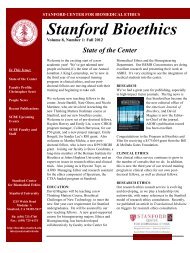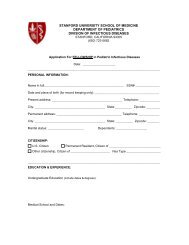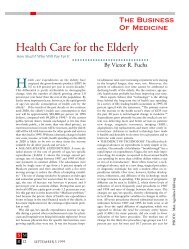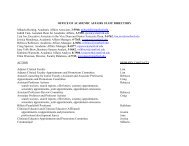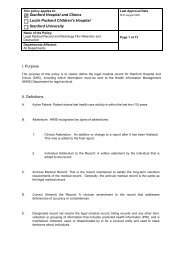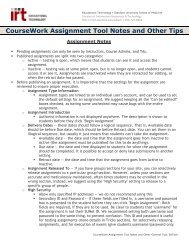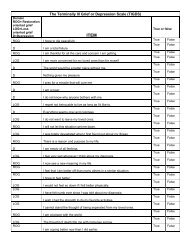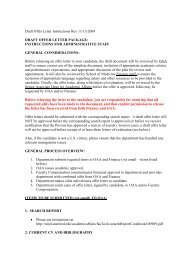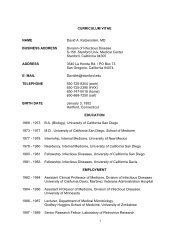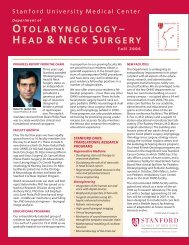Chimeric a2-, frz-Adrenergic Receptors - Stanford University School ...
Chimeric a2-, frz-Adrenergic Receptors - Stanford University School ...
Chimeric a2-, frz-Adrenergic Receptors - Stanford University School ...
Create successful ePaper yourself
Turn your PDF publications into a flip-book with our unique Google optimized e-Paper software.
S<br />
<strong>Chimeric</strong> <strong>a2</strong>-, <strong>frz</strong>-<strong>Adrenergic</strong> <strong>Receptors</strong>:<br />
Delineation of Domains Involved in Effector<br />
Coupling and Ligand Binding Specificity<br />
BRIAN K. KOBILKA, TONG SUN KOBILKA, KIEFER DANIEL,<br />
JOHN W. REGAN, MARc G. CARON, ROBERT J. LEFKOWITZ<br />
The <strong>a2</strong> and I2 adrenergic receptors, both of which are<br />
activated by epinephrine, but which can be differentiated<br />
by selective drugs, have opposite effects (inhibitory and<br />
stimulatory) on the adenylyl cyclase system. The two<br />
receptors are homologous with each other, rhodopsin,<br />
and other receptors coupled to guanine nucleotide regulatory<br />
proteins and they contain seven hydrophobic domains,<br />
which may represent transmembrane spanning<br />
segments. The function of specific structural domains of<br />
these receptors was determined after construction and<br />
expression of a series of chimeric <strong>a2</strong>-,42-adrenergic receptor<br />
genes. The specificity for coupling to the stimulatory<br />
guanine nucleotide regulatory protein lies within a region<br />
extending from the amino terminus of the fifth hydrophobic<br />
domain to the carboxyl terminus of the sixth.<br />
Major determinants of <strong>a2</strong>- and P2-adrenergic receptor<br />
agonist and antagonist ligand binding specificity are contained<br />
within the seventh membrane spanning domain.<br />
<strong>Chimeric</strong> receptors should prove useful for elucidating<br />
the structural basis of receptor fimction.<br />
T t HE ADRENERGIC RECEPTORS (al-, <strong>a2</strong>-, 1I-, AND P2-),<br />
which mediate the physiological effects of catecholamines,<br />
belong to the family of plasma membrane receptors that are<br />
coupled to guanine nucleotide regulatory proteins (G proteins) (1).<br />
This receptor family also includes rhodopsin and the visual color<br />
opsins, the muscarinic cholinergic receptors, and many other neurotransmitter<br />
receptors and receptors for peptide hormones. A common<br />
feature ofG protein-coupled receptors is that agonist occupancy<br />
of the receptor leads to receptor activation of a G protein, which<br />
in turn modulates the activity of an effector enzyme or ion channel.<br />
Several of the G protein-coupled receptors (including the major<br />
subtypes of adrenergic receptors) have been cloned and found to<br />
share structural features with rhodopsin (2). The most consistently<br />
conserved of these features is the existence of seven clusters of<br />
hydrophobic amino acids. In addition, there is significant amino<br />
acid sequence similarity among these receptors, which is most<br />
striking in the hydrophobic domains. For bovine rhodopsin, physical<br />
and biochemical studies have revealed that these hydrophobic<br />
domains may form seven alpha helices that span the lipid bilayer (3).<br />
It has been suggested that these alpha helices form a pocket for the<br />
chromophore 1 1-cis-retinal (3). Thus, in an analogous fashion, the<br />
1310<br />
hydrophobic domains of the adrenergic receptors may form a pocket<br />
in the plasma membrane for binding ligands.<br />
Because so many different hormones, neurotransmitters, and drug<br />
receptors are likely to have structures homologous with the adrenergic<br />
receptors, it is necessary to achieve an understanding of the<br />
structural basis for the various functional properties of these receptors,<br />
in particular the specificity of ligand binding and effector<br />
coupling. This has been done heretofore (i) by mutagenesis, especially<br />
the deletion of specific peptide sequences (4-6), and (ii)<br />
biochemically, where proteases have been used to cleave defined<br />
peptide segments from the digitonin solubilized receptor (7). These<br />
methods, although useful in delineating regions of the receptor that<br />
do not influence its function, suffer from difficulties in that it is<br />
difficult to draw compelling inferences about the role of specific<br />
domains based on loss of functions.<br />
In order to circumvent such problems, and to establish a potentially<br />
general approach to the study of G protein-coupled receptors<br />
so that positive inferences can be drawn about functions associated<br />
with specific receptor domains, we have constructed and expressed a<br />
series of chimeric <strong>a2</strong>,02-adrenergic receptor genes. All of the<br />
subtypes of adrenergic receptors are activated by epinephrine, but<br />
they differ in their affinity for various subtype selective agonists and<br />
antagonists. Furthiermore, the 02-adrenergic receptors (132-AR's)<br />
couple to G. (the stimulatory G protein for adenylyl cyclase) while<br />
the <strong>a2</strong>-adrenergic receptors (<strong>a2</strong>-AR's) couple to Gi (the inhibitory G<br />
protein for adenylyl cyclase). These two receptors therefore, respectively,<br />
stimulate and inhibit the enzyme. By studying the ligand<br />
binding and adenylyl cyclase activating properties of these chimeric<br />
receptors, in which various regions of the <strong>a2</strong>- and P2-adrenergic<br />
receptors have been interchanged, we have deduced structural<br />
domains that determine the specificity of ligand binding and effector<br />
coupling.<br />
The <strong>a2</strong>- and 132-adrenergic receptors. We have described the<br />
cloning of the genes for both the human <strong>a2</strong>-AR (8) and the human<br />
2-AR (9). Both genes have been expressed in Xenopus laevis oocytes<br />
by injecting the oocytes with receptor-specific mRNA (8, 10).<br />
<strong>Receptors</strong> expressed in this way can be detected by binding to<br />
specific radioactively labeled ligands. ['25I]Cyanopindolol can be<br />
used to detect expressed 132-AR (10). The P2-AR expressed in<br />
Xenopus oocyte membranes has an affinity for ['25I]cyanopindolol of<br />
63 pM and has a typical 2-AR agonist order of potency, with<br />
The authors are at the Howard Hughes Medical Institute, Departments of Medicine,<br />
Biochemistry and Physiology, Duke <strong>University</strong> Medical Center, Durham, NC 27710.<br />
SCIENCE, VOL. 240
isoproterenol (3-AR agonist) being more potent than epinephrine<br />
(<strong>a2</strong>- and 3-AR agonist), which in turn is much more potent than paminoclonidine<br />
(<strong>a2</strong>-AR agonist) (Table 1). These agonists, with the<br />
exception of p-aminoclonidine, stimulate 2-AR's, expressed in<br />
Xenopus oocyte membranes, to activate endogeneous adenylyl cyclase<br />
(Table 2).<br />
In contrast to the 2-AR, <strong>a2</strong>-AR expressed in Xenopus oocytes<br />
cannot be detected with [125I]cyanopindolol, but instead binds<br />
[3H]yohimbine (<strong>a2</strong>-AR antagonist) with high affinity (2.5 nM).<br />
Competition binding studies with [3H]yohimbine for <strong>a2</strong>-AR expressed<br />
in Xenopus oocytes show a typical <strong>a2</strong>-AR agonist order of<br />
potency, withp-aminoclonidine (<strong>a2</strong>-AR agonist) being more potent<br />
than epinephrine (<strong>a2</strong>- and (-AR agonist), which is much more<br />
potent than isoproterenol ((3-AR agonist). These binding studies on<br />
<strong>a2</strong>-AR expressed in Xenopus oocytes (8) are in agreement with<br />
studies on <strong>a2</strong>-AR expressed in simian COS-7 cells (Table 3). Thus,<br />
like the 132-AR, expression of the <strong>a2</strong>-AR in Xenopu oocyte mem-<br />
Fig. 1. (A) Diagram of the wild-type, <strong>a2</strong>-adrener- A<br />
gic receptor (<strong>a2</strong>-AR) and the wild-type, 12 recep- 1 2<br />
tor (2-AR). The hydrophobic domains are <strong>a2</strong>AR<br />
shown as forming a-helices that span the plasma L CY-, YCOfN<br />
membrane. These putative a helices are numbered i AC -<br />
1 to 7 from NH2-terminus (extracellular) to the<br />
COOH-terminus (intracellular). (B) <strong>Chimeric</strong> receptors<br />
made from combinations of the wild-type<br />
<strong>a2</strong>-AR and 12-AR. The <strong>a2</strong>-AR sequence is indi- B<br />
cated by a solid line and 02-AR sequence is CR1<br />
indicated by an open line. The <strong>a2</strong>-AR (a) and 12- 14007E413E)<br />
AR (13) amino acid sequences from NH2- to L CYP+. YOHiL<br />
AC+<br />
COOH-terminus are indicated in parentheses be- K AC+>EP>PAC<br />
side each chimeric receptor. (C) Split receptors. COOHc<br />
SR(1-5) represents a truncation of the 2-AR NH<br />
after amino acid 262 while SR(6-7) represents CR2 r<br />
the 2-AR in which amino acids 3 to 261 have 414r17go413) ^<br />
been deleted. Beside each receptor is a summary L AC+<br />
of the functional characteristics of the receptor i tO>EP >PAC<br />
expressed inXenous Iaevis oocytes or COS-7 cells<br />
(or both). The functional properties include: (i) CR3<br />
'2<br />
the ability to bind the 12-AR antagonist 125I- R3<br />
labeled cyanopindolol (CYP) and the <strong>a2</strong>-AR- L CYP+ YOHspecific<br />
antagonist [3H]yohimbine (YOH); (ii) IL O>PAC>e<br />
the ability to couple to G, and activate adenylyl COOHK<br />
cyclase (AC) after stimulation by epinephrine; NH<br />
'2<br />
and (iii) the relative potency of the <strong>a2</strong>- and 132-AR CR4<br />
agonist epinephrine (EPI), the <strong>a2</strong>-AR receptor- L CYP+) OM )<br />
specific agonist p-aminoclonidine (PAC), and the . ACr<br />
1-AR-specific agonist isoproterenol (ISO) for ND<br />
the receptor as determined by ligand binding COOh'<br />
studies or adenylyl cyclase activation N<br />
(or both).<br />
(ND, not determined.) <strong>Chimeric</strong> and split recep- 1CR5<br />
tor genes were constructed by splicing desired L CYP-- YOH-<br />
restriction endonuclease fragments from the wild- i AC-<br />
IL ND<br />
type receptor genes with synthetic oligonucleotide<br />
adapters. The restriction endonuclease fragments<br />
encoding the desired structural domains of C<br />
3 JUNE I988<br />
branes can be documented and characterized by ligand binding.<br />
However, unlike the 132-AR, a functional interaction of adenylyl<br />
cyclase with the <strong>a2</strong>-AR expressed in Xenopus oocyte membranes has<br />
not been observed. Thus, stimulation of <strong>a2</strong>-AR in Xenopus oocyte<br />
membranes does not lead to inhibition of adenylyl cyclase activity.<br />
<strong>Chimeric</strong> receptors. To determine which structural domains of<br />
these two receptors confer specificity for agonist and antagonist<br />
binding as well as G protein coupling, we constructed ten chimeric<br />
receptor genes from the human 132-AR and human platelet <strong>a2</strong>-AR<br />
genes. These chimeric receptor genes were expressed in Xenopus<br />
oocytes and COS-7 cells, and the ability of the chimeric receptors to<br />
bind P2-AR- and <strong>a2</strong>-AR-specific ligands and to activate adenylyl<br />
cyclase was determined. When the ligand binding properties and G<br />
protein-coupling specificities of the various chimeric receptors are<br />
correlated with the <strong>a2</strong>-AR and P32-AR amino acid sequences of these<br />
chimeric receptors, it is possible to assign functional properties to<br />
specific structural domains.<br />
3 4 5 6 7 1 2 3 4 5 6 7<br />
'N2 NH2<br />
L CYAC. YOH-<br />
COOH ACC rL ISO>EPI>PAC<br />
COON 00H<br />
~ ~ ~ ~~ CR6<br />
IXI<br />
I ~~~~~COOHK<br />
-C<br />
-~~~~~~(1295)a(U7-M5 ))<br />
-L CYP-, YOH+<br />
I<br />
L AC+<br />
L EP4ISO8>PAC<br />
LCYP-. YOH-<br />
L AC-<br />
N<br />
CR8<br />
u(1.1 73).(1l744A M747)<br />
L CYP-, YOH+<br />
I AC+<br />
& PAC>EPI>ISO<br />
CR9<br />
L CYP-, YOH4.<br />
L AC+<br />
PAC>EPIBO8<br />
CR10<br />
u(1.173).P(174.262),A(34445O)<br />
-L CYP-, YOH-<br />
L AC-<br />
IL ND<br />
the <strong>a2</strong>-AR and 12-AR were isolated by prepara-<br />
NK12<br />
tive agarose gel electrophoresis. DNA sequences SR(1-5)<br />
SR(6-7)<br />
encoding amino acids not encoded by the DNA in WM).<br />
P(1.2).P23.413)<br />
L CYP-. YOH-<br />
these fragments were synthesized (Applied Bio-<br />
L AC-<br />
COOH<br />
systems model 380 B DNA synthesizer), so that<br />
l<br />
0<br />
the restriction fragments from the wild-type re- Fr ;<br />
ceptors plus the synthetic oligonucleotide adapt- SR(15)+SR('7)<br />
ers together contain all sequences necessary to NACP+YOHencode<br />
a complete chimeric receptor.The oligo- N. 1S>M>PAC<br />
coo<br />
nucleotides were phosphorylated at the 5' hydroxyl<br />
and annealed before the ligation reaction.<br />
-~~~CO<br />
The recombinant genes were identified by restriction endonuclease mapping,<br />
and the splice junctions were evaluated by dideoxy sequencing with the use<br />
of a denatured double-stranded DNA template (14). To ensure uniformity in<br />
the expression of the chimeric receptor, split receptors, and wild-type<br />
receptors, the 3' and 5' untranslated regions of all genes were derived from<br />
the 12-AR cDNA (9). Receptor genes were expressed in Xenopus laevis<br />
AC-<br />
NH2 IiL ND<br />
oocytes by injecting oocytes with mRNA transcribed from the receptor gene<br />
ligated into pSP65 as described for the <strong>a2</strong>-AR and 12-AR (8, 10). Expression<br />
of the genes in COS-7 cells was done by transfecting cells with genes cloned<br />
into pBC12MI in the presence of DEAE-dextran (15). Adenylyl cyclase and<br />
ligand binding assays are described below.<br />
RESEARCH ARTICLES I3I
The structures of each of the ten chimeric receptors and the ability<br />
of each chimeric receptor to bind to ['25I]cyanopindolol or [3H]yohimbine<br />
and to activate adenylyl cyclase after stimulation with<br />
epinephrine are compared in Fig. lB. <strong>Chimeric</strong> receptors (CR) 1, 2,<br />
3, and 4, expressed in Xenpus oocytes, were able to bind [ '25I]cyanopindolol.<br />
Since CR 3 and CR 4 are structurally similar with respect<br />
to the composition of their putative membrane spanning domains,<br />
detailed pharmacologic studies were done on CR 3 as well as CR 1<br />
and CR 2. Saturation binding isotherms and competition binding<br />
studies were done on the P2-AR and on CR 1, CR 2, and CR 3 to<br />
determine the affinity constants for the p-AR antagonists [1251]cyanopindolol<br />
and alprenolol and the agonists isoproterenol, epinephrine,<br />
and p-aminoclonidine (Fig. 2 and Table 1). The <strong>a2</strong>-AR<br />
antagonist yohimbine at a concentration of 0.1 mM did not<br />
compete with ['25I]cyanopindolol for binding sites on these chimeric<br />
receptors.<br />
Table 1. Iodine-125-labeled cyanopindolol binding studies on the human<br />
P2-AR and chimeric receptors (CR). Ligand binding studies were performed<br />
as described in Fig. 2. Saturation isotherms were performed by incubating<br />
membranes with varying concentrations of '251-labeled cyanopindolol in the<br />
presence or absence of 10-5M alprenolol. Equilibrium dissociation constants<br />
were determined from saturation isotherms (Kd) and competition binding<br />
experiments (K1). Saturation isotherm data were analyzed by a nonlinear<br />
least-squares curve-fitting technique (16). Competition curves were analyzed<br />
according to a four-parameter logistic equation to determine EC50 values<br />
(17). The Kd values represent means of two independent experiments each<br />
performed in duplicate. The two independent pKd values were within 10<br />
percent of the mean pKd. The Ki values are from a single experiment<br />
performed in duplicate (Fig. 2) in which all receptors were studied with the<br />
same stock solutions of competing ligands. These values are representative of<br />
two other independent experiments for each receptor in which thepK, values<br />
were within 10 percent.<br />
Equilibrium dissociation constants<br />
Re- Antagonists Agonists<br />
ceptor CYP ALP ISO EPI PAC<br />
Kd (pM) Ki (nM) Ki (p.M) Ki (IpM) Ki (pM1)<br />
VAR 63 1.2 0.42 2.9 770<br />
CR 1 18 2.0 5.4 70 510<br />
CR 2 15 24 16 45 150<br />
CR 3 57 2.0 180 1000 390<br />
Table 2. Agonist mediated stimulation of adenylyl cyclase by the 132-AR, the<br />
<strong>a2</strong>-AR, and chimeric receptors expressed in Xenopus laevis oocyte membranes.<br />
Receptor<br />
Stimu:lation EC50 for agonist stimulation (PM)t<br />
of adenylyl<br />
cyclase*<br />
cyc%ase) ISO EPI PAC<br />
P2-AR 100 0.21 0.41 NSt<br />
<strong>a2</strong>-AR 0 NS NS NS<br />
CR 1 56 2.2 27 NS<br />
CR 2 21 16 60 NS<br />
CR 6 21 280 110 320<br />
CR 8 40 79 39 1.8<br />
CR 9 35 NS 560 40<br />
*The maximnal adenylyl cyclase activity stimulated by a chimeric receptor in the presence<br />
of 10-3M epinephrine expressed as a percentage of the maximal adenylyfcyclase<br />
stimulated by the 2-R. These values represent the mean of two independent<br />
experiments done in duplicate, one of which is shown in Fig. 4. tThe concentration<br />
of an agonist that produces one half the maximal stimulation of adenylvl cyclase activity<br />
evoked by that agonist at 1 mM. The EC50 values represent the mean of two to three<br />
independent experiments done in duplicate (Fig. 5) in which the individual pIC,o<br />
(negative logarithm of the median inhibition concentration) values were within 10<br />
percent of the mean. Agonists include epinephrine (EPI), isoproterenol (ISO), and paminoclonidine<br />
(PAC). Most of the dose response curves for the chimeric receptors do<br />
not plateau by 10-3M agonist and therefore the EC50 values mav be artificially low;<br />
however, they are nonetheless useful in comparing the relative potency of agonists for a<br />
given receptor. tNo stimulation of adenylyl cydase above basal.<br />
1312<br />
[3H]Yohimbine (<strong>a2</strong>-AR antagonist) binding was assayed in COS-<br />
7 cell membranes after transient transfection of these cells with the<br />
chimeric receptor genes. While CR 6 bound [3H]yohimbine weakly,<br />
only CR 8 (Fig. 3) and CR 9 bound [3H]yohimbine with an affinity<br />
high enough to permit determination of affinity constants for<br />
agonists and antagonists (Table 3).<br />
The ability of each chimeric receptor to couple to G, and thus<br />
activate adenylyl cyclase was determined by studying epinephrinestimulated<br />
adenylyl cyclase activity in oocyte membranes expressing<br />
the chimeric receptor. Control oocyte membranes exhibited little or<br />
no epinephrine-stimulated adenylyl cyclase activity. Epinephrine<br />
was used because it is an agonist for both c2-AR and 2-AR, and<br />
thus would be expected to act as an agonist for an <strong>a2</strong>-V2-chimeric<br />
receptor. <strong>Chimeric</strong> receptors 1, 2, 6, 8, and 9 were capable of<br />
activating adenylyl cyclase while CR's 3, 4, 5, 7, and 10 were not.<br />
An epinephrine dose response study was done to determine the<br />
efficiency of agonist stimulated receptor activation of adenylyl<br />
cyclase for CR's 1, 2, 6, 8, and 9 relative to the P2-AR (Fig. 4 and<br />
Table 2). The agonist potency for adenylyl cyclase stimulation of<br />
each chimeric receptor was determined from results of isoproterenol,<br />
epinephrine, and p-aminoclonidine dose response studies on<br />
each chimeric receptor capable of mediating epinephrine-stimulatable<br />
adenylyl cyclase activity (Fig. 5 and Table 2).<br />
G protein coupling. One of our goals was to locate the region of<br />
the 2-AR that is responsible for coupling to Gs and to determine<br />
whether this domain is also involved in ligand binding. Of the<br />
chimeric receptors that can activate adenylyl cyclase, CR 8 and CR 9<br />
contain the shortest stretches of 2-AR. Furthermore, the agonist<br />
order of potency for both cyclase activation and ligand binding for<br />
both of these chimeric receptors resembles ct2-AR in that paminoclonidine<br />
> epinephrine > isoproterenol (Figs. 3 and 5 and<br />
Tables 2 and 3). The 2-AR sequence in CR 8 extends from amino<br />
acid 174 at the NH2-terminal portion of the second putative<br />
extracytoplasmic loop, through the fifth hydrophobic domain and<br />
the third cytoplasmic loop, and ending at amino acid 295 at the<br />
COOH-terminal portion of the sixth hydrophobic domain (Fig. 6).<br />
CR 10, which contains 2-AR amino acid sequence 174 to 261 does<br />
not activate adenylyl cyclase. <strong>Chimeric</strong> receptor 3, which contains<br />
2-AR amino acid sequence 262 to 413 also does not activate<br />
adenylyl cyclase even though it binds [1251]cyanopindolol. <strong>Chimeric</strong><br />
receptor 9 contains 2-AR amino acid residues 215 to 295 and<br />
activates adenylyl cyclase, but the efficiency of this activation is weak<br />
compared to activation by CR 8, as can be seen by comparing the<br />
Table 3. [3H]Yohimbine binding studies with the human <strong>a2</strong>-AR and<br />
chimeric receptors (CRs). Ligand binding studies were performed as<br />
described in Fig. 3. Saturation isotherms were performed by incubating<br />
membranes with varying concentrations of [3H]yohimbine in the presence<br />
or absence of 105M unlabeled yohimbine. Data were obtained and analyzed<br />
as described in the legend to Table 1. The Kd values represent means of two<br />
independent experiments each performed in duplicate. The two independent<br />
pKd values were within 10 percent of the meanpKd. The Kj values are from a<br />
single experiment in which all receptors were studied with the same stock<br />
solutions of competing ligands. These values are representative of two other<br />
independent experiments from each receptor in which the pKj values were<br />
within 10 percent.<br />
Equilibrium dissociation constants<br />
Receptor Antagonists Agonists, Kj (jiM)<br />
YOH ALP ISO EPI PAC<br />
Kd (nM) K (p.M) IS EP PA<br />
<strong>a2</strong>-AR 2.6 5.4 230 1.0 0.074<br />
CR 8 49 3.5 590 40 1.3<br />
CR 9 49 5.5 >1000 46 0.72<br />
SCIENCE, VOL. 240
Q0.<br />
v<br />
c<br />
30<br />
._ io<br />
0<br />
la<br />
Q<br />
0C<br />
0<br />
C.<br />
04<br />
NHA<br />
COOH.<br />
P2 - <strong>Adrenergic</strong> receptor<br />
-NH2<br />
MOOH<br />
<strong>Chimeric</strong> receptor 1<br />
-Log [competitor] (M)<br />
Fig. 2. Competition of adrenergic agents with ['25I]cyanopindolol for binding to the P2-AR and to CR<br />
1, 2, and 3. Messenger RNA was transcribed from these receptor genes ligated into pSP65 as described<br />
in Fig. 1. The mRNA, at a concentration of -0.2 to 0.5 ,ug/,d was injected into stage V-VI Xenopus<br />
laepis oocytes (50 to 100 nl per oocyte). Oocytes were incubated for 18 to 24 hours at 21°C, then oocyte<br />
membranes were prepared and used for ligand binding studies (10). The binding of ['251]cyanopindolol<br />
(20 pmollliter) was assessed in the presence of varying concentrations of epinephrine (EPI),<br />
isoproterenol (ISO), p-aminoclonidine (PAC), and alprenolol (ALP). Assays were performed in 0.5-mil<br />
volumes with 15 to 25 ,g of membrane protein (equivalent to about three to five oocytes) at 25°C for 2<br />
hours and were terminated by filtration through Whatman GF/C filters. The data were analyzed as<br />
described in Table 1 and represent the average of duplicate determinations. These curves are<br />
representative of three independent experiments.<br />
median effective concentration (EC5o) for agonists and the maximal<br />
stimulation of adenylyl cyclase for these chimeric receptors (Fig. 4<br />
and Table 2). These results suggest that, at least, portions of the fifth<br />
and sixth hydrophobic domains may be required for determining<br />
the specificity of V32-AR coupling to G,. Conversely, hydrophobic<br />
domains 1, 2, 3, 4, and 7 as well as the first and second cytoplasmic<br />
loops and the COOH-terminus appear to have little influence in<br />
determining the specificity for G protein coupling.<br />
Studies on site-directed mutagenesis of the hamster V2-AR (5, 6)<br />
and proteolysis of digitonin solubilized turkey ,-AR (7) have<br />
addressed the issue of which structural domains may be involved in<br />
coupling of the ,B-AR to G,. Deletion of several small segments of<br />
the third cytoplasmic loop of the hamster 2-AR does not affect G<br />
protein coupling (5, 6). The region of the human P2-AR analogous<br />
to the hamster 132-AR in the region of these deletions extends from<br />
amino acid residues 229 through 262 (Fig. 6). Also, deletion of<br />
sequences at the NH2- and COOH-terminal portions of the third<br />
cytoplasmic loop in the hamster ,B2-AR leads to loss of G, activation<br />
(6). In the human 2-AR (Fig. 6), these deletions would correspond<br />
to amino acid 222 to 229 and amino acid 258 to 270, respectively.<br />
These studies therefore provide clues to the potential sites of<br />
interaction between the V2-AR and G,; however, it is also possible<br />
that the negative effect of these deletion mutations might be due to<br />
an allosteric rather than a direct effect on the actual G protein<br />
coupling domain.<br />
Proteolysis studies on the turkey 3-AR suggest that deletion of<br />
even larger regions of the third cytoplasmic loop, and possibly of the<br />
fifth hydrophobic domain, do not affect the ability of the receptor to<br />
couple to G, (7). However, with this approach it was difficult to<br />
define the precise position of some of the proteolytic cleavage sites.<br />
Our results define a limited region of the human ,32-AR which,<br />
when placed in the analogous position of the human <strong>a2</strong>-AR, confers<br />
the ability to couple to and activate G, with an <strong>a2</strong>-AR agonist order<br />
of potency. More detailed resolution of the precise sequences<br />
3 JUNE I988<br />
Q<br />
CL<br />
3<br />
0<br />
0<br />
IC<br />
0<br />
co<br />
L)<br />
n<br />
cooH ~ ~ ~ ~ ~<br />
COOHi<br />
<strong>Chimeric</strong> receptor 2<br />
NH2<br />
COOHJ<br />
<strong>Chimeric</strong> receptor 3<br />
-Log [competitor] (M)<br />
necessary for receptor-Gs coupling will be achieved by insertion of<br />
smaller segments of the 132-AR into the <strong>a2</strong>-AR and by single amino<br />
acid substitutions.<br />
Ligand binding. A number of studies have suggested that the<br />
hydrophobic domains of the 132-AR are involved in the formation of<br />
the ligand binding pocket. In constructing and studying the series of<br />
<strong>a2</strong>- and P2-AR chimeric receptors an attempt was made to determine<br />
which domains conferred ligand binding specificity for agonists<br />
and antagonists. Since each chimeric receptor is an artificial<br />
combination of <strong>a2</strong>- and 2-AR, it might not be expected to function<br />
as well as either of the native receptors (see below). Attention was<br />
therefore focused on the relative order of potencies for agonists and<br />
antagonists rather than the absolute affinities for the different<br />
agents. Thus, each chimeric receptor can be classified as having an<br />
<strong>a2</strong>-AR or j32-AR agonist or antagonist potency series. These<br />
determinations were made on the basis of both ligand binding (for<br />
those chimeric receptors capable of binding either ['251]cyanopindolol<br />
or [3H]yohimbine) and adenylyl cyclase assays.<br />
A comparison of ['25I]cyanopindolol binding studies (Fig. 2 and<br />
Table 1) and adenylyl cyclase studies (Table 2) on the native 132-AR<br />
with those on CR 1, 2, and 3 suggests that hydrophobic domains 1<br />
to 5 are not involved in a major way in determining 2-AR<br />
antagonist specificity. All of these chimeric receptors bind<br />
[1251]cyanopindolol with an affinity equivalent to or higher than the<br />
native ,32-AR (Table 1).<br />
A somewhat different picture emerges for the agonists. The<br />
affinity of all agonists for CR 1, 2, and 3 was significantly lower than<br />
for the 132-AR. Moreover, a progressively changing specificity for<br />
RESEARCH ARTICLES 1313
Fig. 3 (left). Competition of adrenergic agents NH<br />
with [3H]yohimbine for binding to CR 8 ex- - - -><br />
pressed in COS-7 cells. Cells were rinsed with -2--S- I,AR<br />
phosphate-buffered saline, scraped from the cul- I1J<br />
ture flasks, and homogenized in ice-cold 5 mM .8 3.0<br />
tris-HCI, pH 7.4, and 2 mM EDTA with a <strong>Chimeric</strong> receptor 8 /<br />
Polytron (five bursts of 5 seconds at maximum a CR1<br />
setting). The lysate was adjusted to 75 mM tris- 2 XI<br />
HCI, pH 7.4,12.5 mM MgCI2 and 2 mM EDTA > 25 =<br />
and used for ligand binding studies. The binding j 2.0<br />
of [3H]yohimbine (20 nM) was assessed in the<br />
presence of varying concentrations of the indicat- o20 PPi<br />
ed agonists and antagonists. Assays were per- IC CR8<br />
formed in 0.5-ml volumes with 50 to 100 Rg of E \A<br />
membrane protein for 2 hours at 250C, and the O 15 _ CR9<br />
reactions were terminated by filtration through > lo /<br />
Whatman GF/C glass fiber filters. Data were 1 \ I<br />
analyzed as described in Table 3 and represent the 0> CR2<br />
average of duplicate determinations. These curves 7 6 5 4 3<br />
are representative of three independent experi-<br />
ments. Fig. 4 (right). Dose response of epi- -Log [competitor] (M)<br />
nephrine for stimulation of adenylyl cydase activi-<br />
0<br />
ty mediated by the ,82-AR and chimeric receptors. Xnopus laevis oocytes harvested from the same frog 8 7 6 5 4 3<br />
were injected with equivalent amounts of mRNA transcribed from receptor genes in the mRNA -Log [epinephrine] (M)<br />
expression vector pSP65. Membrane preparations and adenylyl cyclase assays were performed as<br />
described (10). Each data point represents the mean of triplicate determinations. Each determination was performed on membranes from 25 to 35 mRNA-injected<br />
Xenps iaevis oocytes. Adenylyl cyclase activity above basal (unstimulated) activity is expressed as a fraction of the basal activity, that is, the difference<br />
between the agonist stimulated value (X) and the basal value (1Y) divided by the basal value [(X - Y)/Y]. Thus a value of 1.0 represents a doubling ofthe basal<br />
value by agonist or a 100 percent increase above basal. Typical basal values range from 0.3 to 1.0 pmol of cyclic AMP per milligram of membrane protein per<br />
minute. The experiment shown is representative of two independent experiments.<br />
agonists can be appreciated by considering the ratio of Ki's for the<br />
<strong>a2</strong>-AR agonist p-aminoclonidine and the 3-AR agonist isoproterenol<br />
[Ki(PAC)/K1(ISO)]. At the two extremes, the ratio ofKi(PAC)<br />
to K,(ISO) was 1800 for the 132-AR and 0.00032 for the <strong>a2</strong>-AR.<br />
The values for the chimeric receptors were: CR 1, 94; CR 2, 9.4;<br />
and CR 3, 2.2. Thus, as the extent of <strong>a2</strong>-AR sequence increases the<br />
receptor becomes progressively less "B2-AR-like" in its agonist<br />
binding properties.<br />
Our data on the chimeric receptors, in particular the ligand<br />
binding properties of CR 9, suggest that the sixth hydrophobic<br />
domain does not exert a major influence on either agonist or<br />
antagonist order of potency. However, the seventh hydrophobic<br />
domain appears to be a major determinant of both agonist and<br />
antagonist ligand binding specificity. A study of CR 6 shows that<br />
replacement of the seventh hydrophobic domain in the 132-AR with<br />
the seventh hydrophobic domain from the <strong>a2</strong>-AR leads to a loss of<br />
[125I]cyanopindolol binding and the acquisition of the ability to<br />
bind [3H]yohimbine, albeit with low affinity. Furthermore, isoproterenol<br />
is less potent than epinephrine in stimulating adenylyl<br />
cyclase via CR 6, and p-aminoclonidine is able to activate adenylyl<br />
cyclase (Table 2).<br />
The importance of the seventh hydrophobic domain in conferring<br />
<strong>a2</strong>-agonist and antagonist specificity can be further illustrated by<br />
comparing CR 2 and 8. In CR 2, hydrophobic domains 1 to 4 are<br />
derived from the <strong>a2</strong>-AR and hydrophobic domains 5 to 7 are<br />
derived from the 132-AR. This chimeric receptor exhibits predominantly<br />
12-AR ligand binding properties (Fig. 2C). <strong>Chimeric</strong> receptor<br />
8 is made by changing the seventh hydrophobic domain in CR 2<br />
from 2-AR to <strong>a2</strong>-AR (see Fig. 1B). In contrast to chimeric CR 2,<br />
CR 8 exhibits <strong>a2</strong>-AR agonist and antagonist ligand binding properties<br />
(Fig. 3 and Table 3), and activates adenylyl cyclase with an <strong>a2</strong>-<br />
AR agonist order of potency (Fig. 5). Thus, changing the seventh<br />
hydrophobic domain in CR 2 from P2-AR to <strong>a2</strong>-AR results in a<br />
change in the ratio of Ki(PAC) to K1(ISO) from 9.4 to 0.0022.<br />
These data indicate that most of the hydrophobic domains<br />
influence agonist ligand binding specificity, while antagonist ligand<br />
binding specificity (at least for [ H]yohimbine, ['25I]cyanopindolol,<br />
and alprenolol) is influenced primarily by the seventh hydrophobic<br />
I3I4<br />
2.0 -<br />
domain or the combination of the sixth and the seventh. Thus, CR<br />
3, which contains only hydrophobic domains 6 and 7 from the 12-<br />
AR, has affinities for [1 5I]cyanopindolol and alprenolol that are<br />
close to the affinities of these ligands for the wild-type 132-AR.<br />
Split receptor. The role of hydrophobic domains 6 and 7 in<br />
binding to [125I]cyanopindolol was then explored. The 132-AR was<br />
expressed as two separate peptides (see Fig. 1C), one encoding<br />
amino acid 1 to 262, containing hydrophobic domains 1 to 5,<br />
SR(1-5), and the other containing hydrophobic domains 6 to 7,<br />
SR(6-7). We constructed SR(1-5) by inserting a termination<br />
codon after amino acid 262. This mutant does not bind ligands or<br />
activate adenylyl cyclase (10). We made SR(6-7) by deleting the<br />
region between the second amino acid of the 32-AR and amino acid<br />
262. It is possible to express SR(1-5) and SR(6-7) together in<br />
Xenopus oocytes and obtain a functional receptor with a Kd for<br />
[1251]cyanopindolol of 44 pM and normal 2-AR affinities for<br />
isoproterenol, epinephrine, and norepinephrine (Fig. 7). This "split<br />
receptor" can also activate adenylyl cyclase, although it is only -25<br />
percent as efficient as the wild-type P2-AR in doing so. However,<br />
injection of mRNA for SR(6-7) alone does not lead to the<br />
expression of a '251-labeled cyanopindolol binding protein in the<br />
oocyte membranes. This suggests that, even though hydrophobic<br />
domain 7 (or 6 and 7) appear to be the major determinants of 132-<br />
AR ligand binding specificity, this region of the molecule by itself is<br />
insufficient to bind P2-AR ligands or activate adenylyl cylcase.<br />
While these results suggest that the seventh hydrophobic domain<br />
is involved in dictating ligand binding specificity, it cannot be<br />
concluded that this hydrophobic domain forms the ligand binding<br />
pocket. This domain may confer ligand binding specificity by<br />
interaction with the domains directly involved in the formation of<br />
the binding site. The 1-AR-specific photoaffinity antagonist<br />
pBABC covalently binds to a peptide in the second hydrophobic<br />
domain (11) suggesting that this domain may form or lie adjacent to<br />
the ligand binding pocket. Site-directed mutagenesis of various<br />
residues in different domains of 2-R leads to alteration of ligand<br />
binding properties (4, 12). While these findings may indicate that<br />
the mutated regions are involved in the formation of the ligand<br />
binding site, they may also be due to allosteric effects.<br />
SCIENCE, VOL. 240
0<br />
.0<br />
0<br />
1.5<br />
0<br />
. as a0 0<br />
0 c<br />
0-<br />
a<br />
0 0<br />
0 0<br />
5<br />
C<br />
0<br />
vI D<br />
<strong>Chimeric</strong> receptor 8<br />
7 6 5 4 3<br />
-Log [agonist] (M)<br />
Fig. 5 (left). Adenylyl cyclase activity stimulated via CR 8. Xenopus oocyte<br />
membranes containing CR 8 were assayed for adenylyl cyclase at varying<br />
concentrations of the indicated agonists. The methods are described in Fig.<br />
4. Each data point represents the mean of two independent experiments in<br />
which determinations were done in duplicate. Each determination was<br />
performed with membranes from 25 to 35 mRNA-injected Xenopus laevis<br />
oocytes. Adenylyl cyclase is expressed as described in Fig. 4. Fig. 6<br />
(center). 02-AR amino acid sequence of CR 8. The diagram of CR 8 is<br />
shown at the top. The open line represents ,82-AR sequence. The amino acids<br />
derived from the P2-AR are shown in the larger diagram as circles. Black<br />
circles with white letters represent amino acid identities between the <strong>a2</strong>-AR<br />
Possible arrangement of hydrophobic domains. The study of<br />
this set of chimeric receptors has provided insight into the function<br />
of various structural domains. However, these molecules may also<br />
provide clues about the arrangement of the various hydrophobic<br />
domains within the parent molecules. These hydrophobic domains<br />
may form a-helices that span the plasma membrane, as has been<br />
suggested by electron diffraction studies on bacteriorhodopsin (13).<br />
For the following discussion we therefore refer to the hydrophobic<br />
domains as membrane spanning a-helices. The arrangement of these<br />
a-helices with respect to each other might be dictated by the<br />
interactions of various charged, noncharged polar, and nonpolar<br />
amino acids as well as the possible formation of covalent bonds (that<br />
is, disulfide bridges). The less hydrophobic amino acids of these a<br />
helices are likely to project toward the interior of the molecule, while<br />
the more hydrophobic residues may form a boundary with the<br />
plasma membrane. The a helices that lie adjacent to each other have<br />
presumably evolved in such a way as to minimize steric and<br />
electrostatic repulsive forces between each other.<br />
In the process of making chimeric receptors these favorable<br />
molecular interactions may be lost. For example, in making CR 1, ahelix<br />
2 from the <strong>a2</strong>-AR and a-helix 3 from the 2-AR are forced to<br />
lie adjacent to each other. Furthermore, other a helices that may<br />
normally cluster around a-helices 1 and 2 from the V2-AR may be<br />
less compatible with a-helices 1 and 2 from the <strong>a2</strong>-AR. These<br />
molecular incompatibilities might be expected to destabilize the<br />
molecule, and thus make it less efficient or even nonfunctional. This<br />
is consistent with the finding that all chimeric receptors in this series<br />
are less efficient than either parent molecule in binding agonists, and<br />
less efficient than the 2-AR in activating G,. Furthermore, chimeric<br />
receptors containing two molecular splice junctions such as CR 7, 8,<br />
9, and 10 (Fig. 1), might be expected to function even less well than<br />
chimeric receptors with only one splice junction. For example, while<br />
CR 1 and CR 6 are both able to couple to and activate G,, CR 7,<br />
3 JUNE I988<br />
NH2<br />
H<br />
NH2<br />
coo<br />
SpNtreeporSR1-)H S(NH<br />
Split receptor SR(1-5) + SR(6-7)<br />
7 6 5<br />
-Log [competitor] (M)<br />
and 02-AR. The numbered amino acid residues are discussed in the<br />
text. Fig. 7 (right). Agonist competition binding studies on split<br />
receptors. SR(1-5) and SR(6-7) were expressed together in Xenpus Iaeis<br />
oocytes. Messenger RNA transcribed from SR(1-5) and SR(6-7) genes in<br />
the mRNA expression vector pSP65 was mixed and injected into Xenpus<br />
laevis oocytes. After 24 hours, membranes were prepared and competitionbinding<br />
was performed as described in Fig. 2. Varying concentrations of<br />
isoproterenol (ISO), epinephrine (EPI), and norepinephrine (NOREPI)<br />
competed for binding sites with 75 pM '25I-labeled cyanopindolol. Data<br />
were analyzed as described in Table 1.<br />
which contains both molecular splice junctions found in CR 1 and<br />
CR 6, is nonfunctional even though it contains the essential<br />
elements of P2-AR necessary to activate Gs.<br />
<strong>Chimeric</strong> receptor 8 is of particular interest, therefore, since it<br />
contains two molecular splice junctions, yet has a higher affinity for<br />
epinephrine (Tables 1 and 3) and is more efficient at activating<br />
adenylyl cyclase (Table 2) than either CR 2 or CR 6, each of which<br />
contains only one of the two molecular splice junctions found in CR<br />
8 (Fig. 1). This observation might be explained by considering the<br />
possible arrangement of hydrophobic domains in the <strong>a2</strong>-AR and<br />
various chimeric receptors (Fig. 8). The model proposes that a-helix<br />
7 of the <strong>a2</strong>-AR and CR 1, 6, 7, and 8 lie adjacent to a-helices 3 and<br />
4. In CR 6 (Fig. 8B) a-helix 7 from the <strong>a2</strong>-AR is paired with a-helix<br />
3 and 4 from the 2-AR and is therefore less stable. Similarly in CR<br />
2 (Fig. 8C), a-helix 7 from the 2-AR is paired with a-helices 3 and<br />
4 from the <strong>a2</strong>-AR. However, in CR 8 (Fig. 8D) a-helices 3,4, and 7<br />
are all from the <strong>a2</strong>-AR. Thus, the potential molecular incompatabilities<br />
between a-helix 4 and a-helix 5 and between a-helix 6 and ahelix<br />
7 in CR 8 are compensated for by the opportunity for a-helix 7<br />
to interact normally with a-helices 3 and 4 from the same receptor.<br />
In the nonfunctional CR 7 (Fig. 8E), potential incompatibilities<br />
between a-helix 7 and a-helices 3 and 4 as well as between a-helix 2<br />
and a-helix 3 and between a-helix 6 and a-helix 7 may contribute to<br />
the lack of activity of this receptor. Thus, on the basis of the<br />
functional capacity of chimeric receptors, it may be possible to<br />
predict the arrangement of a-helices within the parent molecules.<br />
Only CR 5, 7, and 10 are nonfunctional; that is, they do not bind<br />
[3H]yohimbine or [1251]cyanopindolol, nor do they activate adenylyl<br />
cyclase. Sequence analysis of the splice junctions of these chimeric<br />
receptor genes confirmed that these chimeric receptors were properly<br />
constructed. Furthermore, in vitro translation of mRNA made<br />
from these chimeric receptor genes produced a protein of the<br />
predicted molecular size. While the lack offunction of these chimeric<br />
RESEARCH ARTICLES 13I5
Fig. 8. Possible arrangement of hydrophobic<br />
domains for the <strong>a2</strong>-AR<br />
and various chimeric receptors. The<br />
hydrophobic domains are depicted<br />
as a-helices as they would appear<br />
from above the plasma membrane<br />
(A). Alpha helices from the <strong>a2</strong>-AR<br />
are shown as black circles with<br />
white numbers while those from<br />
02-AR are shown as white circles<br />
with black numbers. Potential destabilizing<br />
interactions between ahelices<br />
from different receptors are<br />
indicated by arrows. The model<br />
attempts to explain the observation<br />
that CR 8 (D) functions better than<br />
CR 6 (B), CR 2 (C), or CR 7 (E)<br />
as assessed by affinity for epinephrine<br />
(Tables 1 and 3) and by activation<br />
of adenylyl cyclase (Table 2).<br />
B CR6<br />
D CR8<br />
A oX2AR<br />
* <strong>a2</strong>AR nant of both agonist and antagonist ligand binding specificity.<br />
O ,e AR Finally, several of the first five hydrophobic domains may contribute<br />
to agonist binding specificity. The strength of this approach for the<br />
study ofthese functionally complex molecules is that conclusions can<br />
be drawn from qualitative changes in receptor function, or from the<br />
acquisition of new functions that can be correlated with specific<br />
protein sequences. This is in contrast with more standard mutagenesis<br />
approaches where the end point is the loss of finction resulting<br />
from amino acid deletions or substitutions. Our results provide an<br />
C CR2 initial structural map for understanding the various functions oftwo<br />
model G protein-coupled receptors. The map requires further<br />
refinement and testing of its generality for understanding receptors<br />
of this class.<br />
E CR7<br />
receptors might be explained by molecular incompatibilities between<br />
oa-helices as discussed above, it is also possible that these<br />
chimeric receptors failed to insert properly in the plasma membrane<br />
as a result of specific amino acid sequences created at the splice<br />
junctions. This may be particularly important for CR 5 and CR 10<br />
which have a splice junction in the putative third cytoplasmic loop in<br />
a region where the <strong>a2</strong>-AR and 32-AR share little amino acid<br />
sequence similarity.<br />
The results from our study of chimeric receptors made from the<br />
2-AR and <strong>a2</strong>-AR have provided new insights into the functional<br />
role of several structural domains. The fifth and sixth hydrophobic<br />
domains and the third cytoplasmic loop are capable of conferring<br />
specificity for G, coupling to the P2-AR. The seventh hydrophobic<br />
domain of the <strong>a2</strong>- and P2-adrenergic receptors is a major determi-<br />
L<br />
I3I6<br />
1988<br />
REFERENCES AND NOTES<br />
1. A. G. Gilman,Annu. Rev. Biochem. 56, 615 (1987).<br />
2. H. G. Dohlman, M. G. Caron, R. J. Lefkowit, Biochematy 26, 2657 (1987).<br />
3. J. B. C. Findlay and D. J. C. Pappin, Biochem. J. 238, 625 (1987).<br />
4. R. A. F. Dixon et al., EMBO J. 6 (11), 3269 (1987).<br />
5. R. A. F. Dixon et al., Nature 326, 73 (1987).<br />
6. C. D. Strader et al., J. Biol. Chem. 262, 16439 (1987).<br />
7. R. C. Rubenstein, S. K.-F. Wong, E. M. Ross, ibid., p. 16655.<br />
8. B. K. Kobilka et al., Scinc 238, 650 (1987).<br />
9. B. K. Kobilka ct al., Proc. Natl. Acad. Sai. U.S.A. 84, 46 (1987).<br />
10. B. K. Kobilka at al., J. Biol. Chem. 262, 15796 (1987).<br />
11. H. G. Dohlman, M. G. Caron, C. D. Strader, N. Amlaiky, R. J. Lefkowitz,<br />
Biochemisty 27, 1813 (1988).<br />
12. C. D. Strader ect al., Proc. Nati. Acad. Sci. U.S.A. 84, 4384 (1987).<br />
13. R. Henderson and P. N. T. Unwin, Naturc 257, 28 (1975).<br />
14. F. Sanger, S. Nicklen, A. R. Coulson, Proc. Natl. Acad. Sci. U.S.A. 74, 5463<br />
(1977).<br />
15. B. Cullen, Methods in Enzymlo. 152, 684 (1987).<br />
16. A. DeLean, A. A. Hancock, R. J. Lcfkowitz, Mol. Pharmacol. 21, 5 (1982).<br />
17. A. DeLean, P. T. Munson, A. Rodbard, Am. J. Physiol. 235, 97 (1978).<br />
18. We thank M. Holben for preparation of the manuscript, and 0. Finn for<br />
introducing us to the Xenpus oocyte expression system. Supported in part by NIH<br />
grant HL 16037.<br />
25 February 1988; accepted 28 April 1988<br />
AAAS Philip Hauge Abelson Prize<br />
To Be Awarded to a Public Servant or Scientist<br />
The AAAS Philip Hauge Abelson Prize of $2,500 and a<br />
commemorative plaque, established by the AAAS Board of<br />
Directors in 1985, is awarded annually either to:<br />
(a) a public servant, in recognition of sustained exceptional<br />
contributions to advanced science, or<br />
(b) a scientist whose career has been distinguished both for<br />
scientific achievement and for other notable services to the<br />
scientific communitv.<br />
AAAS members are invited to submit nominations now for<br />
the 1988 prize, to be awarded at the 1989 Annual Meeting<br />
in San Francisco. Each nomination must be seconded by at<br />
least two other AAAS members. The prize recipient will be<br />
selected by a seven-member panel appointed by the Board. The<br />
recipient's travel and hotel expenses incurred in attending the<br />
award presentation will be reimbursed.<br />
Nominations should be typed and should include the following<br />
information: nominee's name, institutional affiliation and<br />
tide, address, and brief biographical resume; statement of justification<br />
for nomination; and names, identification, and signatures<br />
of the three or more AAAS member sponsors.<br />
Eight copies of the complete nomination should be submitted<br />
to the AAAS Executive Office, 1333 H Street, N.W., Washington,<br />
D.C. 20005, for receipt on or before 1 August 1988.<br />
SCIENCE, VOL. 240






